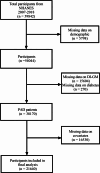The relationship between dietary index for gut microbiota and diabetes
- PMID: 39979448
- PMCID: PMC11842723
- DOI: 10.1038/s41598-025-90854-y
The relationship between dietary index for gut microbiota and diabetes
Abstract
This study aims to explore the relationship between the Dietary Index for Gut Microbiota (DI-GM) and diabetes. In recent years, there has been increasing attention to the role of the gut microbiome in regulating host metabolism. However, the relationship between DI-GM and the risk of diabetes has not been sufficiently studied. This study utilized relevant data from the National Health and Nutrition Examination Survey (NHANES) 2007-2018. Multiple logistic regression analysis was conducted to explore the relationship between DI-GM and the risk of diabetes. The dose-response relationship between DI-GM and the risk of diabetes was observed using restricted cubic splines (RCS). Threshold effect analysis was performed based on RCS results. Subgroup analyses were used to conduct a sensitivity analysis of the relationship between DI-GM and the risk of diabetes. The results from multiple logistic regression analysis indicated a significant negative correlation between DI-GM and the risk of diabetes (OR, 0.954, 95%CI, 0.918-0.991). RCS results also showed a significant nonlinear negative relationship between DI-GM and the risk of diabetes (P < 0.001, P for nonlinear = 0.010). The threshold effect analysis revealed that when DI-GM was below 6.191, there was a significant negative correlation between DI-GM and the risk of diabetes (OR, 0.921, 95% CI, 0.876-0.969). However, when DI-GM exceeded 6.191, the relationship between DI-GM and the risk of diabetes was no longer significant. Subgroup analysis revealed that the negative correlation between DI-GM and the risk of diabetes remained significant in Whites, participants with a poverty-income ratio > 3.5, body mass index > 24, current drinkers, never or current smokers, and those without chronic kidney disease (P < 0.05). This study demonstrates a nonlinear negative correlation between DI-GM and the risk of diabetes. Maintaining DI-GM above 6.191 may help prevent diabetes.
Keywords: Diabetes; Dietary index for gut microbiota; NHANES; Nonlinear relationship; Threshold effect.
© 2025. The Author(s).
Conflict of interest statement
Declarations. Competing interests: The authors declare no competing interests. Ethical approval: The original NHANES research data were collected after obtaining informed consent from all participants, with ethical approval from the NCHS Institutional Review Board. Secondary analysis of publicly available data does not require ethical approval.
Figures
References
-
- Lovic, D. et al. The growing epidemic of diabetes mellitus. Curr. Vasc Pharmacol.18, 104–109 (2020). - PubMed
-
- Cloete, L. Diabetes mellitus: An overview of the types, symptoms, complications and management. Nurs. Stand.37, 61–66 (2022). - PubMed
-
- Tao, Z., Shi, A. & Zhao, J. Epidemiological perspectives of diabetes. Cell. Biochem. Biophys.73, 181–185 (2015). - PubMed
MeSH terms
Grants and funding
LinkOut - more resources
Full Text Sources
Medical




